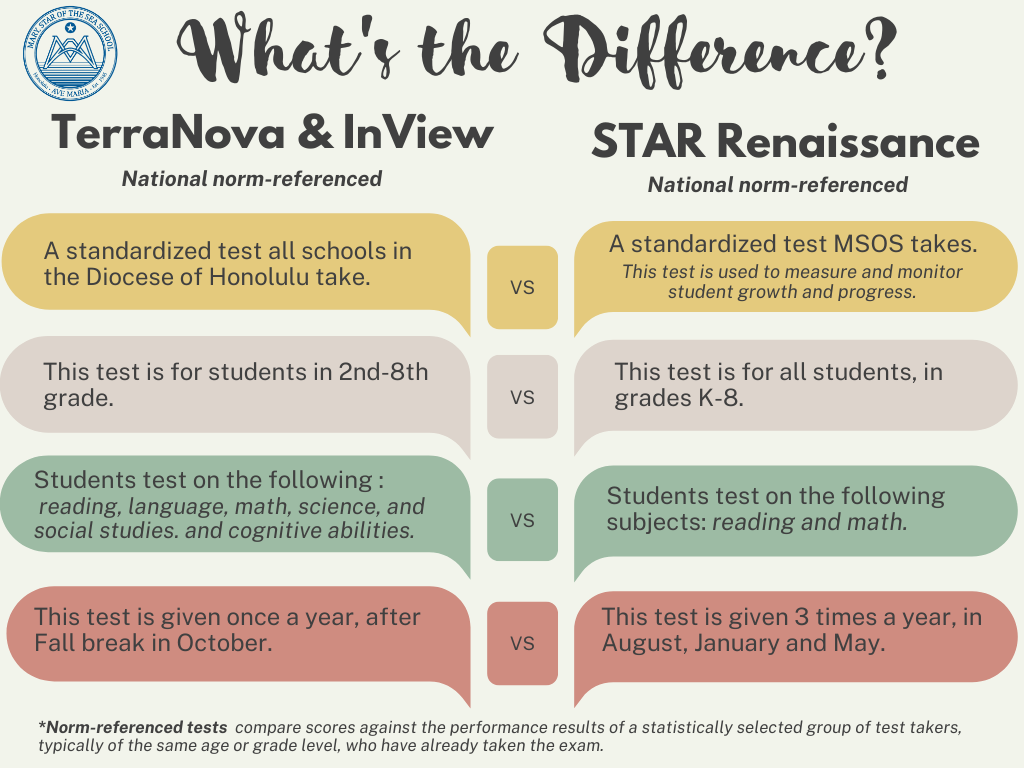MSOS administers standardized achievement testing as a part of their comprehensive assessment program. The new TerraNova-Complete Battery achievement tests, created by Data Recognition Corporation (DRC), and the InView Assessment include norms developed in the year 2018 and measure student progress toward National Standards. These assessment results will not impact report card grades.
What are Standardized Tests? Standardized tests are meant to show proof of progress. They are not pass/fail tests. The test results show how your student compares nationally to other students in the same grade level who took the same test at the same time of year (Fall, Midyear, or Spring) when the test was normed.

TerraNova Standardized Testing
The TerraNova Test is a national, norm-referenced* achievement assessment measures achievement in reading, language arts, mathematics, science, and social studies.
- TerraNova assessments are administered to students in Grades 2 through 8 and is a mandated Diocesan standardized testing program.
- The following is a list of several uses of the data from the Terra Nova tests used by our faculty:
- Obtain a measure of student growth over time
- Assist in curriculum planning and improvement of instruction.
- Use to gauge progress of students towards mastery of national standards
- Terra Nova is administered once a year, usually in the Fall.
InView is an assessment of cognitive abilities that includes verbal reasoning, sequences, analogies, and quantitative reasoning. The results provide a reliable measure of skills and abilities important for academic success. It is administered with the Terra Nova.
How does MSOS use the results from TerraNova? It is important to recognize that standardized testing, while valuable, constitutes only a small part of the school’s evaluation program. It should be recognized that standardized testing serves some purposes better than others, that there are limitations and strengths in each of the various techniques used to measure student progress, and that assessment is a means to an end and not an end in itself.
How does a parent use these scores? The score from a single battery of tests is not necessarily going to be an accurate indication of overall understanding of a content area. With this in mind, it is recommended that all reporting of student achievement be used to form an observation of strengths and areas of need for each student. The data from TerraNova and STAR is considered an external assessment, and along with all of the internal (i.e. classroom) assessments this information can be used to guide instruction.
How do I know how my child did on the tests? Parents will receive their child’s assessment results, usually at the end of the semester that the test was administered.
What do the scores tell me about my child? When you receive your child’s results from the TerraNova tests on the Home Report, you are seeing a National Percentile Score that represents the percent of students in the nation your child did better than. Keep in mind however, that these tests sample our curriculum and that a more comprehensive view of your child’s academic progress is evidenced by all the data we collect during the school year.
What do the scores tell the school? To a certain extent, the TerraNova Tests are external evaluations of how our school is doing by measuring commonly accepted academic content standards and college and career readiness standards. There are several “points of view” that may be taken from the data: One might be to compare ourselves to a national average to answer the question: ∙ Are we average, about average, or above average as a grade group in the content measured by the test? ∙ Another might be to compare this year’s group of students to those from last year, and the year before that in order to get a trend line.
What does the school do with this information? The value of a test such as TerraNova lies in the fact that it is a standardized test and from this we can develop trend data over the years. Using trend data provides for making adjustments of curriculum emphasis if and where necessary.
STAR RENAISSANCE STANDARDIZED TESTING
Why does MSOS use STAR Assessments as well? — STAR is a national, norm-referenced, computer-adaptive achievement assessment of general reading, comprehension, and math.
- Administered to students in grades K–8. This standardized test is optional for diocesan schools.
- Used for screening and progress-monitoring assessment
- STAR assessments are administered throughout the school year and take about 30 minutes to complete. This makes the assessment efficient and convenient to administer.
STAR Early Literacy (grades K-1)
Star Early Literacy measures both early literacy and early numeracy in a single assessment, providing reliable and valid data about students’ phonological awareness, phonics, word recognition, fluency (including estimated oral reading fluency), and vocabulary as well as early number recognition, counting operations and algebraic thinking, and measurement.
STAR Reading (grades 1-8)
Assesses students vocabulary, comprehension, analyzing literary text, understanding author’s craft and analyzing argument and evaluating text. This K–12 comprehensive assessment provides all the insights needed to guide literacy growth for emergent readers, struggling readers, and high achievers,
STAR Math (grades 1-8)
Assesses students in the following domains: numbers and operations, algebra, geometry and measurement, and data analysis, statistics, and probability. Increases math mastery with actionable insight into each student’s math skills and subskills by using the Star Math data to connect each student at every grade level with the concepts they need for future success.
*Norm-referenced tests compare scores against the performance results of a statistically selected group of test takers, typically of the same age or grade level, who have already taken the exam.